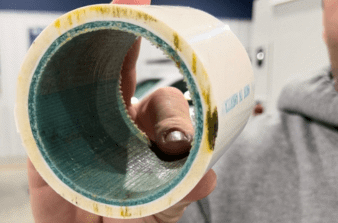When faced with a damaged drain line, property owners often grapple with what the best solution is for restoring their system to full capacity. The average homeowner may not be aware that there are alternative solutions to excavating the line and replacing the entire pipe.
Trenchless pipe lining, also known as cured-in-place pipe (CIPP) lining, is an advanced and non-invasive method used to repair damaged or deteriorating pipes without the need for extensive excavation. It involves inserting a flexible liner coated with resin into the existing pipe and curing it to create a new, seamless inner layer. This process effectively restores the structural integrity of the pipe, enhances its durability, and eliminates common issues such as leaks, cracks, or root intrusion. Trenchless pipe lining is a cost-effective, time-efficient, and environmentally friendly solution that minimizes disruption to properties while providing long-lasting results for various plumbing applications.
In this blog, we highlight five compelling reasons why trenchless pipe lining emerges as the superior choice over traditional drain line replacement methods. Discover the advantages of this innovative technique and make an informed decision for your plumbing needs.
Cost-Effectiveness
- Pipe lining offers overall cost savings compared to a complete drain line replacement. By eliminating the need for extensive excavation and pipe removal, the labor and site restoration expenses are significantly reduced. Pipe lining significantly minimizes property restoration costs, as there is minimal disruption to landscaping, hardscaping, and structures.
Time Efficiency
- The process of pipe lining is considerably faster than traditional drain line replacement. With minimal excavation required, the repair can be completed in a fraction of the time, allowing you to restore your plumbing system and regain functionality quickly. The entire pipe restoration can be completed from a single access point by a single plumbing contractor, eliminating the need to coordinate repairs with additional contractors for concrete, flooring, landscaping, hardscaping and other affected areas. Reduced downtime means less inconvenience for you and your family or business.
Minimal Disruption
- Replacing a drain line often involves extensive digging, which can disrupt your property and daily routine. In contrast, pipe lining is a trenchless technology that requires only small access points to insert and cure the liner. This non-invasive approach preserves your landscape, minimizes noise, and ensures a cleaner and more efficient repair process.
Enhanced Longevity
- Pipe lining provides a durable and long-lasting solution for damaged drain lines. The cured-in-place liner creates a seamless, jointless pipe within the existing one, eliminating weak points susceptible to future damage. The new lining is resistant to corrosion, cracks, and root intrusion, extending the lifespan of your plumbing system and reducing the need for future repairs. Thomas Plumbing provides a ten year warranty on all pipe lining projects.
Environmental Sustainability
- By opting for pipe lining, you contribute to environmental conservation. This method significantly reduces excavation and material waste associated with traditional drain line replacement, thereby minimizing the carbon footprint. Choosing a more sustainable solution aligns with eco-conscious values and helps preserve the planet for future generations.
When it comes to repairing a damaged drain line, pipe lining emerges as the superior option for multiple reasons. Its cost-effectiveness, time efficiency, minimal disruption, enhanced longevity, and environmental sustainability make it a compelling choice. Embrace this innovative trenchless technology and experience the benefits of a reliable and long-lasting plumbing solution. Trust pipe lining to restore your drain line, ensuring optimal functionality while minimizing costs and inconveniences.

